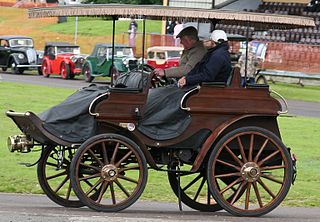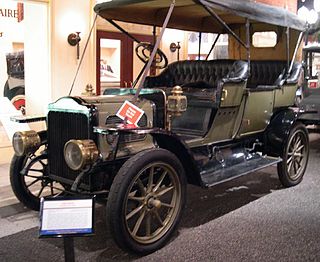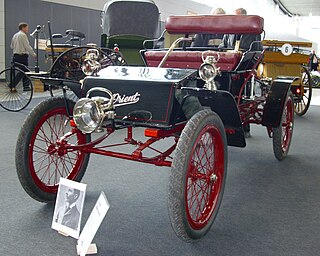
The Overland Automobile Company was an American automobile manufacturer in Toledo, Ohio. It was the founding company of Willys-Overland and one of the earliest mass producers of automobiles.
The Locomobile Company of America was a pioneering American automobile manufacturer founded in 1899, and known for its dedication to precision before the assembly-line era. It was one of the earliest car manufacturers in the advent of the automobile age. For the first two years after its founding, the company was located in Watertown, Massachusetts. Production was transferred to Bridgeport, Connecticut, in 1900, where it remained until the company's demise in 1929. The company manufactured affordable, small steam cars until 1903, when production switched entirely to internal combustion-powered luxury automobiles. Locomobile was taken over in 1922 by Durant Motors and eventually went out of business in 1929. All cars produced by the original company were always sold under the brand name Locomobile.

Panhard was a French motor vehicle manufacturer that began as one of the first makers of automobiles. It was a manufacturer of light tactical and military vehicles. Its final incarnation, now owned by Renault Trucks Defense, was formed by the acquisition of Panhard by Auverland in 2005, and then by Renault in 2012. In 2018 Renault Trucks Defense, ACMAT and Panhard combined under a single brand, Arquus.
The Adams Company is an American manufacturing concern. It was founded in 1883 and is based in Dubuque, Iowa, United States.

NSU Motorenwerke AG, or NSU, was a German manufacturer of automobiles, motorcycles and pedal cycles, founded in 1873. Acquired by Volkswagen Group in 1969, VW merged NSU with Auto Union, creating Audi NSU Auto Union AG, ultimately Audi. The name NSU originated as an abbreviation of "Neckarsulm", the city where NSU was located.

Arrol-Johnston was an early Scottish manufacturer of automobiles, which operated from 1895 to 1931 and produced the first automobile manufactured in Britain. The company also developed the world's first "off-road" vehicle for the Egyptian government, and another designed to travel on ice and snow for Ernest Shackleton's Nimrod Expedition to the South Pole.

L'Aster, Aster, Ateliers de Construction Mecanique l'Aster, was a French manufacturer of automobiles and the leading supplier of engines to other manufacturers from the late 1890s until circa 1910/12. Although primarily known as an engine mass manufacturer the company also produced chassis for coach-works and a complete range of components.

De Dion-Bouton was a French automobile manufacturer and railcar manufacturer, which operated from 1883 to 1953. The company was founded by the Marquis Jules-Albert de Dion, Georges Bouton, and Bouton's brother-in-law Charles Trépardoux.

A Steam Car is a car (automobile) propelled by a steam engine. A steam engine is an external combustion engine (ECE), whereas the gasoline and diesel engines that eventually became standard are internal combustion engines (ICE). ECEs have a lower thermal efficiency, but carbon monoxide production is more readily regulated.
The Lanchester Motor Company Limited was a British car manufacturer in active trade between 1899 and 1955. Though the Lanchester Motor Company Limited is still registered as an active company and accounts are filed each year, the marque has been dormant since. As of 2014 it is marked as "non-trading".

The Knox Automobile Company was a manufacturer of automobiles in Springfield, Massachusetts, United States, between 1900 and 1914. Knox also built trucks and farm tractors until 1924. They are notable for building the very first modern fire engine in 1905, and the first American vehicle with hydraulic brakes, in 1915.
The National Motor Vehicle Company was an American manufacturer of automobiles in Indianapolis, Indiana, between 1900 and 1924. One of its presidents, Arthur C. Newby, was also one of the investors who created the Indianapolis Motor Speedway.

Waltham Manufacturing Company (WMC) was a manufacturer of bicycles, motorcycles, motorized tricycles and quadricycles, buckboards, and automobiles in Waltham, Massachusetts. It sold products under the brand names Orient, Waltham, and Waltham-Orient. The company was founded in 1893, moving to self-propelled vehicles after 1898.

Woods Motor Vehicle Company was an American manufacturer of electric automobiles in Chicago, Illinois, between 1899 and 1916. In 1915 they produced the Dual Power with both electric and internal combustion engines which continued until 1918.

The Swift Motor Company made Swift Cars in Coventry, England from 1900 until 1931. It grew progressively from James Starley's Coventry Sewing Machine Company, via bicycle and motorised cycle manufacture. The cars ranged from a single-cylinder car in 1900 using an MMC engine, through a Swift-engined twin-cylinder 7-horsepower light car in 1904, and a 3-litre model in 1913. After the First World War a successful range was sold during the 1920s, but the Cadet of 1930 was its last vehicle as it could not compete economically with volume manufacturers such as Ford and Morris Motors.

A motorized bicycle is a bicycle with an attached motor or engine and transmission used either to power the vehicle unassisted, or to assist with pedalling. Since it sometimes retains both pedals and a discrete connected drive for rider-powered propulsion, the motorized bicycle is in technical terms a true bicycle, albeit a power-assisted one. Typically they are incapable of speeds above 52 km/h (32 mph); however, in recent years larger motors have been built, allowing bikes to reach speeds of upwards of 113 km/h.
Standard Motor Construction Company (1904-1905) was the successor to the U. S. Long Distance Automobile Company (1900-1903) of Jersey City, New Jersey. The American Veteran Era Long Distance automobile was developed into the Standard automobile in 1904.
The history of the motorcycle begins in the second half of the 19th century. Motorcycles are descended from the "safety bicycle," a bicycle with front and rear wheels of the same size and a pedal crank mechanism to drive the rear wheel. Despite some early landmarks in its development, the motorcycle lacks a rigid pedigree that can be traced back to a single idea or machine. Instead, the idea seems to have occurred to numerous engineers and inventors around Europe at around the same time.

Straker-Squire was a British automobile manufacturer based in Bristol, and later Edmonton in North London.
The Welch Motor Company was an American automobile company headquartered in Chelsea, Michigan. It began in 1901 and continued production of luxury vehicles until 1911 when it merged with General Motors.













